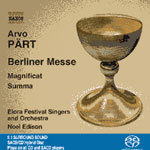
Berliner Messe / Stabat Mater / Summa
 $28.00
Out of Stock
$28.00
Out of Stock6+ weeks add to cart
ARVO PART
Berliner Messe / Stabat Mater / Summa
Elora Festival Singers / Elora Festival Orchestra / Noel Edison, conductor
[ Naxos SACD / SACD ]
Release Date: Friday 26 August 2005
This item is currently out of stock. It may take 6 or more weeks to obtain from when you place your order as this is a specialist product.
Born in Paide, Estonia on 11th September 1935, Arvo Pärt studied in Tallinn with Harri Otsa and Veljo Tormis, then at the Tallinn Conservatoire with Heino Eller, graduating in 1963.
SACD/Hybrid 5.1 surround sound - Playable on all compact disc players.
Born in Paide, Estonia on 11th September 1935, Arvo Pärt studied in Tallinn with Harri Otsa and Veljo Tormis, then at the Tallinn Conservatoire with Heino Eller, graduating in 1963. While his earliest works adopted an undemanding neo-classical style, his clandestine study of serial composition made itself apparent in Nekrolog (1960), heralding a series of scores, including Perpetuum Mobile and the First 'Polyphonic' Symphony, which afforded Pärt notoriety amid the warily-conservative establishment of the period. A growing interest in the music of Bach led Pärt to combine the famous B-A-C-H motif with often wildly extraneous material, as in the cello concerto Pro et Contra and the Second Symphony (both 1966). The climax of this period came with Credo (1968), in which Bach and Modernism openly conflict in a work whose overt Christianity was considered a direct challenge to Soviet officialdom.
Rather than pursue this line of thinking, Pärt retreated into near silence. The Third Symphony of 1971 [Naxos 8.554591] gave notice of an intense interest in early music, notably Gregorian Chant, but it was not until 1976 that he again began to compose fluently, using a tonal technique he termed tintinnabuli, in which the bell-like resonance of notes in a triad underscores a melodic voice which revolves step-wise around a central pitch. A number of works considered modern classics followed, notably Tabula Rasa [Naxos 8.554591], Fratres and Cantus in memoriam Benjamin Britten [both on Naxos 8.553750], culminating in 1982 with Pärt's largest work thus far, the St John Passion [Naxos 8.555860]. This paved the way for a sequence of mainly sacred choral works, consolidating Pärt's reputation among the most significant composers at work today. The present recording provides an overview of his mature idiom, with works written either side of the Passion, and in which a gradual expressive opening-out and harmonic enrichment of Pärt's musical vocabulary can be detected.
Composed in 1977 and revised in 1996, Cantate Domino is a setting of Psalm XCV for fourpart chorus and organ. The simple, chant-like melody is heard in a number of harmonizations and registral combinations, with the sparing organ part adding a subtle degree of colour to the vocal writing.
Commissioned for the Ninetieth Deutsche Katholikentag in Berlin, Pärt's Berliner Messe was composed during 1990-91 and revised six years later. Originally scored for four solo voices and organ, it was subsequently arranged either for choir and organ or, as on the present recording, for choir and strings. After an elegiac Kyrie, in which strings intertwine with the choir's supplications, the Gloria effects a more animated manner within the same restricted tonal and harmonic compass. In the first of two departures from the customary Mass liturgy, Pärt interpolates a First and Second Alleluia which warm the choral textures with their major-mode radiance. There follows an extensive setting of the Veni Sancte Spiritus, in which alternate responses from the four vocal registers unfold over a static pedal in lower strings, and with upper strings articulating the vocal harmony at key points. The Credo is a direct rewrite of Summa (see below), here sounding a mood of easeful contentment. Not so the Sanctus, the inward, ruminative manner of which is pursued to a more rarified degree in the Agnus Dei, which ends the work in a mood of calm, etiolated detachment.
A setting of Psalm CXXIX for male chorus, organ and ad libitum percussion complement, De Profundis was sketched in 1977 but completed only in 1980, after Pärt's temporary move to Vienna, and dedicated to the Austrian composer Gottfried von Einem. The effortful initial progress of tenors and basses is touched off by a flickering organ ostinato and punctuated by quiet bass drum strokes and chimes from a single tubular bell, rising in a gradual crescendo then easing back to its initial dynamic level, before the almost peremptory conclusion.
Composed in 1977 for soprano, alto, tenor and bass soloists or choir, Summa was recast in 1990 as the Credo in Pärt's Berliner Messe, at which time it was also arranged for string quartet [Naxos 8.553750]. Unlike the revision, the original version proceeds unequivocally in the minor mode, an indication, perhaps, of the genesis of the piece at a time when public avowal of religious faith was forbidden in Estonia.
Pärt's first work to a English text, The Beatitudes, was written for the RIAS Chamber Choir in Berlin and completed in 1990 (with revisions the following year). The consistency of this setting of St Matthew, ch.V, vv. 3-12, is evident in the musical phrasing, which, in its combination of short and long notes, emphasizes salient words in the text. Again, there is a gradual crescendo, culminating here in a fervent Amen and an intense organ postlude which fades out of earshot in the closing bars.
Commissioned by Deutsche Musikrat, and first given by the Staats- und Domchor of Berlin in 1989, the Magnificat is perhaps Pärt's most immediately appealing choral work. The alternation of solo and tutti sections imparts a powerful spiritual aura, and, as so often with this composer, there is no attempt to 'set' the text as in classical composition over the preceding three or more centuries.
Tracks:
Cantate Domine Canticum Novum
Berliner Messe
De Profundis
Summa
The Beatitudes
Magnificat
